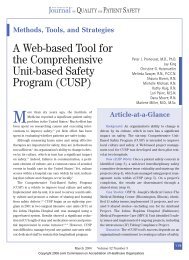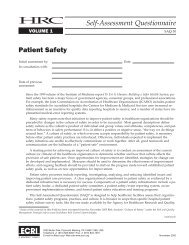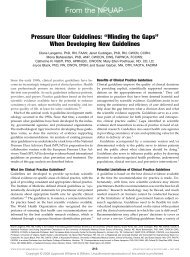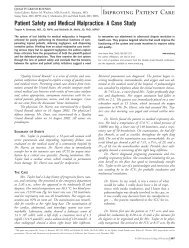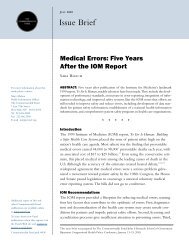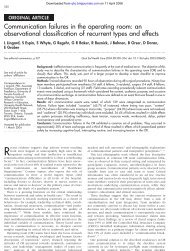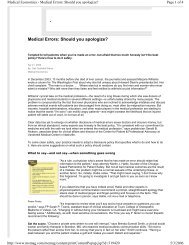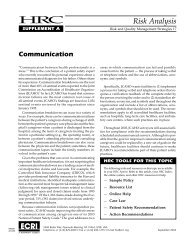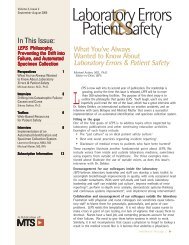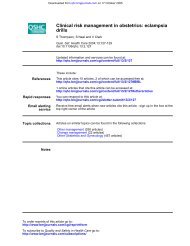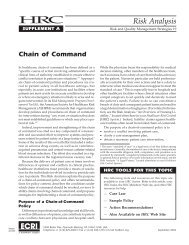Shoulder Dystocia - Lippincott Williams & Wilkins
Shoulder Dystocia - Lippincott Williams & Wilkins
Shoulder Dystocia - Lippincott Williams & Wilkins
Create successful ePaper yourself
Turn your PDF publications into a flip-book with our unique Google optimized e-Paper software.
<strong>Shoulder</strong> <strong>Dystocia</strong> 17<br />
more often during pregnancy, every 2 weeks instead of<br />
monthly, to provide more frequent nutrition coaching.<br />
They many benefit from a referral to a nutritionist. Nutrition<br />
counseling for some women may be obtained<br />
through the Women, Infants and Children’s Supplemental<br />
Nutrition Program (WIC). Obese women may<br />
qualify for WIC, for example, by being anemic. Women<br />
who are overweight or obese demonstrate periods of<br />
excess caloric intake, not necessarily adequate nutrient<br />
ingestion.<br />
Diabetes in pregnancy<br />
Obesity and excessive weight gain are risk factors<br />
for gestational diabetes. 13 Pregestational and gestational<br />
diabetes complicated by obesity, poor glycemic<br />
control, or excessive weight gain increase risk for<br />
shoulder dystocia. 1,17,13 All pregnant women should<br />
be screened for diabetes during pregnancy by using<br />
national standards. 13 The 2005 American College of<br />
Obstetricians and Gynecologists standards for obesity<br />
management during pregnancy advise consideration of<br />
gestational diabetes screening at the first-trimester firstprenatal<br />
visit with repeated screening later in pregnancy<br />
if the first screen is within a reference range. 13<br />
The prenatal nurse can ensure that these guidelines<br />
are integrated into practice and that abnormal screens<br />
are followed by 3-hour glucose testing and treatment<br />
as needed. Testing, treatment plans, and blood glucose<br />
records should be copied into the prenatal record so<br />
that all providers can assess progress with glucose control.<br />
If diabetes management is provided by a perinatologist<br />
or diabetologist outside of the prenatal practice,<br />
the nurse can enhance communication between<br />
practices by seeing that both practices have copies of<br />
laboratory values, visit records, and consultation summaries.<br />
These complete records should also be available<br />
in the prenatal records that are used for the labor<br />
and delivery record.<br />
Macrosomia<br />
Regular fundal height assessment during prenatal visits<br />
documents fetal growth and can be a screen for<br />
macrosomia. 17 Estimated fetal weight based on clinical<br />
palpation including Leopold’s maneuvers is as accurate<br />
as ultrasound estimation of fetal weight 17 ; therefore,<br />
nurses should practice their palpation skills and<br />
have confidence in their ability to estimate fetal size.<br />
The estimated weight of fetuses with fundal heights<br />
greater than 40 cm should be measured carefully. Fetal<br />
chest circumferences equaling or exceeding fetal head<br />
circumferences measured by ultrasound may indicate<br />
shoulder dystocia risk. 3 When estimated fetal weight<br />
exceeds 5000 g in women without diabetes and 4500 g<br />
in women with diabetes, the prenatal care provider<br />
needs to determine whether an induction of labor or<br />
elective cesarean birth is indicated and whether a plan<br />
has been made with the mother for the timing and manner<br />
of birth. 1,18<br />
PRIOR SHOULDER DYSTOCIA<br />
A previous shoulder dystocia with or without brachial<br />
plexus injury should be recorded on the prenatal problem<br />
list. 10 A prior shoulder dystocia increases the risk<br />
for a subsequent shoulder dystocia (9.8%–16.7%), although<br />
most subsequent births do not involve shoulder<br />
dystocia. 19 Women who have had a prior shoulder dystocia<br />
need careful informed consent on prenatal weight<br />
gain, the risk of recurrence, and birth options. 1,10 The<br />
prenatal care provider should form a plan for time and<br />
place of birth with the mother that is documented in<br />
the prenatal record. The nurse can help prepare the<br />
mother for scheduled births by teaching about induction<br />
of labor or presurgical routines.<br />
CHILDBIRTH PREPARATION<br />
Nurses who teach childbirth preparation can prepare<br />
mothers and their families for the common maneuvers<br />
used in shoulder dystocia management without scaring<br />
the family with worst-case complications. 10 The childbirth<br />
preparation nurse can say,<br />
Some large newborns are tight fits through the vagina. The<br />
labor and delivery nurses may help you pull your legs back<br />
to your chest to help move the pubic bone over the baby’s<br />
shoulder. A nurse might also push down just above your pubic<br />
bone to nudge the baby’s shoulder under the bone. Sometimes<br />
the midwife or doctor might put a hand behind the<br />
baby’s back to push it sideways into a large part of the pelvis<br />
so the shoulders move down.<br />
Mothers can practice McRobert’s maneuver in class by<br />
pulling their legs to their chests while sitting on the<br />
floor resting against their seated coaches. The childbirth<br />
preparation teacher can demonstrate suprapubic<br />
pressure on a recumbent mother without using any<br />
pressure.<br />
INTRAPARTUM NURSING PREVENTION<br />
OF SHOULDER DYSTOCIA<br />
Risk assessment<br />
Although shoulder dystocia is unpredictable, the labor<br />
admission history and physical examination give the<br />
labor nurse the opportunity to recognize risk factors



